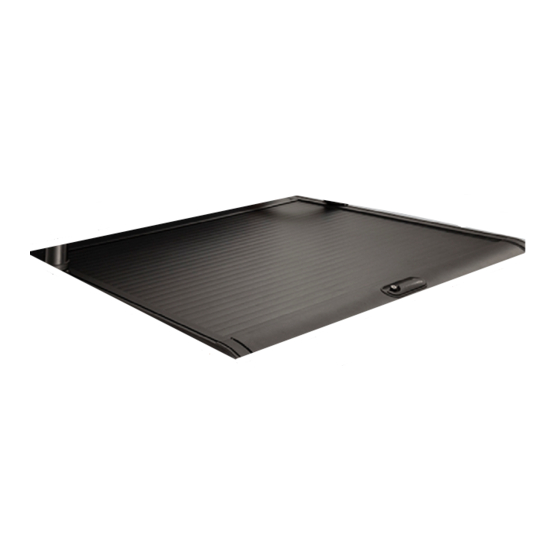
Subscribe to Our Youtube Channel
Summary of Contents for Mitsubishi MOTORS KJ0
- Page 1 OWNER’S MANUAL Part Name: RETRACTABLE TONNEAU COVER Part Number: MZ315100 Model Series: PRINT FORMAT: A5 BOOKLET Document No. / Part. No. Issue Date Page MZ315100 20 June 2019 Cover 886 024-3...
- Page 2 Document No. / Part. No. Issue Date Page MZ315100 19 June 2019 886 024-3...
-
Page 3: Table Of Contents
Contents Retractable Tonneau Cover Owner’s manual Conditions of use p. 2 Warnings p. 4 Functions p. 5 Release locking system p. 6 Spring adjustment p. 8 Maintenance General cleaning p. 9 Cleaning the canister p. 10 Lubrication p. 11 Clamps p. -
Page 4: Conditions Of Use
Conditions of use The Retractable Tonneau Cover is made of aluminium, plastics, and rubber. To ensure a smooth and trouble free operation, it’s advised to follow this manual. The Retractable Tonneau Cover has been designed for normal driving conditions on roads;... - Page 5 Fig. 1 Fig. 2 Fig. 3 Fig. 4 The cover is not designed for loading although it can support normal snow loads. No part of it can support any load from cargo or persons and the product might be dam- aged if somebody stands on it.
-
Page 6: Warnings
Fig. 5 Fig. 6 Fig. 7 Fig. 8 Warnings Do not drive with persons under the cover. Do not allow persons or animals to stay in the bed when the cover is closed. Temperatures can be very high under the cover when closed. (Fig. -
Page 7: Functions
Fig. 9 Fig. 10 Fig. 11 Fig. 12 Functions To open The Retractable Tonneau cover: Make sure the cover is unlocked (Fig. 9+10) Pull back on the handle, and press down on the lock cylinder (Fig. 11) Use the pull strap to gently open the cover (Fig. -
Page 8: Release Locking System
Fig. 13 Fig. 14 Fig. 15 Fig. 16 Release locking system The Retractable Tonneau Cover features a locking system with multiple locking points along the profiles. When the locking system is engaged, the cover will lock in these 4 positions: Fully open. - Page 9 Fig. 17 Fig. 18 Fig. 19 Fig. 20 To toggle the locking system, pull the strap either left (engage) or right (disengage). (Fig. 17+18) When the cover is fully opened, a lock activator is automatically triggered, engaging the locking system. (Fig.19) For the cover to close correctly, the locking system must be engaged before the cover is closed.
-
Page 10: Spring Adjustment
Fig. 21 Fig. 22 Fig. 23 Spring adjustment The main spring is positioned in the main shaft in the canister. The spring tension has been adjusted by delivery and is ready to use. Spring tension can easily be adjusted. At the right side of the canister end piece there is a pinion. -
Page 11: General Cleaning
Fig. 24 Fig. 25 General cleaning The cover should be cleaned on a regular basis using water with normal car shampoo. (Fig. 24) Drains should be cleaned often to assure proper function of water management (Fig. 25) When cleaning, use a soft, lint free cloth or brush. Rinse soap foam off thoroughly with fresh water, and dry with a clean cloth. -
Page 12: Cleaning The Canister
Fig. 26 Fig. 27 Fig. 28 Fig. 29 Cleaning the canister The canister should be cleaned at least once a year removing dirt and debris. The lid over the canister needs to be removed for this operation and should be carefully reassembled. Take care not to lose the plastic screw caps Remove the 6 screws on the lid. -
Page 13: Lubrication
Fig. 30 Fig. 31 Lubrication The lock should be lubricated regularly using a suitable lock lubricant (e.g. Würth lock spray), or similar. (Fig. 30) Seals and side profiles should be cleaned and lubricated regularly using silicon (e.g. Würth Silicon Oil), or similar. (Fig. -
Page 14: Clamps
Fig. 32 8 Nm +1000 km +15000 km Clamps The clamps should be positioned correctly, and re-tightened to 8 Nm (Fig. 32) at these intervals : 1000 km after first use. Check all screw connections and fastenings of rollcover, tighten and/or readjust as necessary and check again at regular intervals. -
Page 15: Accessories
Fig. 33 Fig. 34 Accessories Cargo Carrier (Fig. 33) Combined load capacity of 75 Kg (including bars) (Fig. 34) Lockable end-caps Moveable MZ315100 20 June 2019 13/13 886 024-3...





Need help?
Do you have a question about the KJ0 and is the answer not in the manual?
Questions and answers